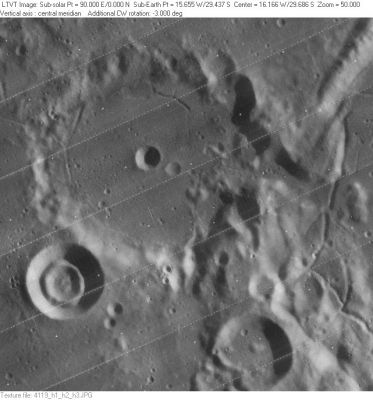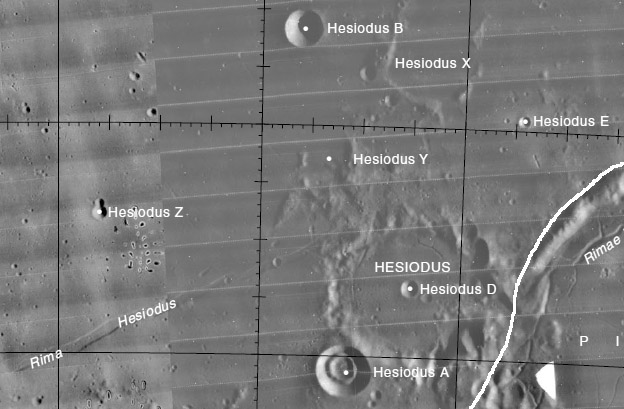Hesiodus
Contents
Hesiodus
|
Lat: 29.4°S, Long: 16.3°W, Diam: 42 km, Depth: 0.45 km, [/R%C3%BCkl%2054 Rükl 54] |
Table of Contents

LO-IV-119H Hesiodus is in the upper left with 106-km [/Pitatus Pitatus] partially visible on the right. The fresh 5-km crater on Hesiodus' floor is Hesiodus D while the famous 15-km concentric crater Hesiodus A is to the southwest. Another (but less famous) 15-km crater, [/Pitatus Pitatus] H, is in the lower right. The rilles on the floor of [/Pitatus Pitatus] are part of the IAU-named [/Rimae%20Pitatus Rimae Pitatus] system. Those on the floor of Hesiodus are unnamed. The channel connecting the floors of Hesodius and [/Pitatus Pitatus] is an unusual feature, and a cone of light seen on the floor of Hesiodus as the Sun rises over this area has often been attributed to it. In truth, the channel deviates too much from a true east-west direction for the rising Sun to stream through it, but the rays of sunlight certainly pass over lower features in its vicinity than they do elsewhere.
Images
LPOD Photo Gallery Lunar Orbiter Images
Hesiodus A; the most famous one of all Concentric Craters on the moon's surface (included in C.A.Wood's list as N°22), was captured on four of Lunar Orbiter 4's photographs:
LOIV-119-h3 (near the frame's upper left corner).
LOIV-120-h1 (near the frame's lower left corner).
LOIV-124-h3 (near the frame's right margin, about "halfway").
LOIV-125-h1 (near the frame's lower right corner).
Research: Danny Caes
Maps
([/LAC%20zone LAC zone] 94C4) LAC map Geologic map
Description
Description: Elger
([/IAU%20Directions IAU Directions]) HESIODUS.--This walled-plain, little more than half the diameter of [/PITATUS PITATUS], has an irregular outline, and for the most part linear walls, which on the S. are massive and lofty (4,000 feet), but on the N. very low, and broken by gaps. There is a fine deep crater on the S. border, and a small but distinct crater on the floor, nearly central, the only object thereon which I have seen, though Schmidt draws a smaller one on the E. of it.
A mountain abutting on the N.W. side of Hesiodus is the E. origin of one of the longest clefts on the moon. Running in an W.S.W. direction, it traverses the Mare to a crater near the E. face of the Cichus mountain arm, reappears on the W. side of this object, and is finally lost amid the hills on the N. of [/Capuanus Capuanus]. The E. section of this cleft is coarser and much more distinct than that lying W. of the mountain arm.
Description: Wikipedia
Additional Information
- Depth data from [/Kurt%20Fisher%20crater%20depths Kurt Fisher database]
- Pike, 1976: 0.45 km
- Westfall, 2000: 0.45 km
- Cherrington, 1969: 1.4 km
- Hesiodus A is the most famous [/concentric%20crater concentric crater] on the Moon.
Nomenclature
- Named for Hesiod (Greek: Hesiodus) (c. 735 B.C.), an early Greek poet and rhapsode, who presumably lived around 700 BC. Hesiod's writings serve as a major source for knowledge of Greek mythology, farming techniques, archaic Greek astronomy and ancient time-keeping.
- According to [/Whitaker Whitaker] (p. 220), this name was introduced by [/M%C3%A4dler Mädler].
- Hesiodus B, a small bowl-shaped crater north-northwest of Hesiodus itself, was once known as Roy (Louis Roy). This was one of Felix Chemla Lamech's new names, but the I.A.U. did not accept that name.
- Research Lamech's Roy: Ewen A. Whitaker and Danny Caes (August 2003, mail correspondence).
- Hesiodus Ray; a well known clair-obscur effect which is always observable during local sunrise circumstances. See APOD article Hesiodus Sunrise Ray (below).
Lettered Craters

Excerpt from the USGS Digital Atlas of the Moon.
LPOD Articles
Happy Thanksgiving.
Smaller and Smaller Rilles
APOD Articles
Bibliography
- Lamech's "Roy": [/Mapping%20and%20Naming%20the%20Moon Mapping and Naming the Moon]; a history of lunar cartography and nomenclature (Ewen A. Whitaker).
- Alan M. MacRobert. 1996. The Sunrise Ray in Hesiodus. Sky and Telescope Vol. 92, No. 1 (July issue), pp. 74-76.
This page has been edited 1 times. The last modification was made by - tychocrater tychocrater on Jun 13, 2009 3:24 pm - afx2u2